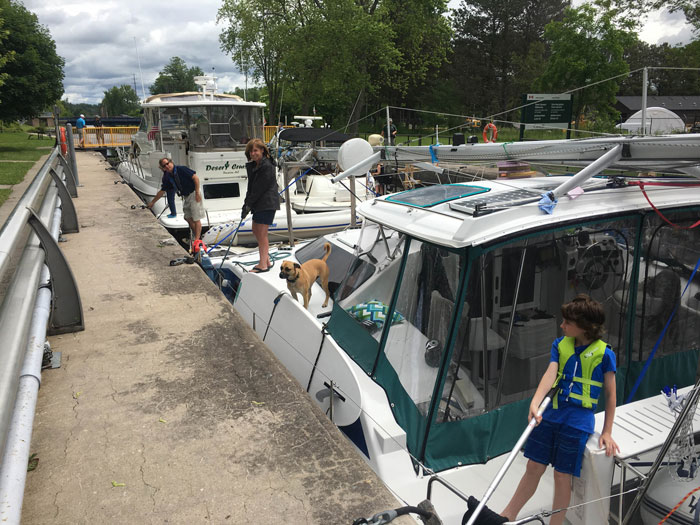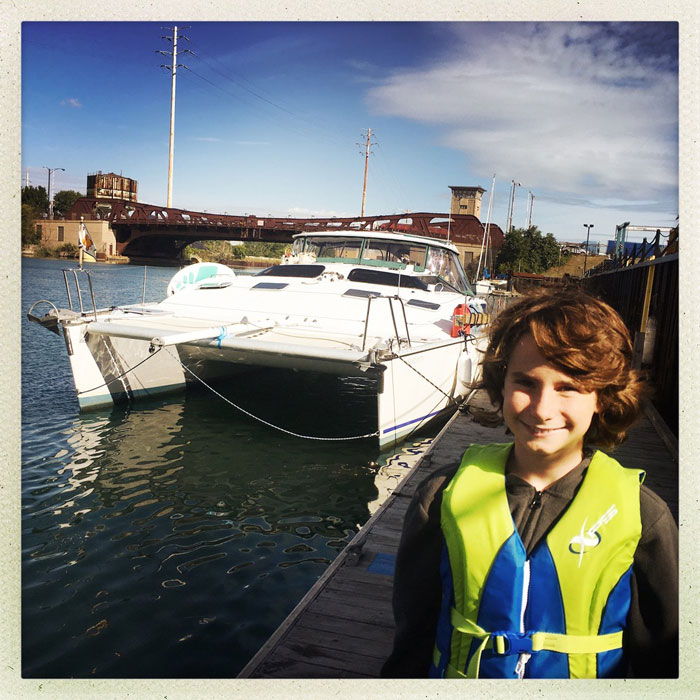The Great Loop on a Sailboat: Handling the Mast
Traversing the Great Loop, a system of waterways that encompasses the eastern portion of the United States and part of Canada, is a bucket list item for many boat owners. The trip demands navigating dozens of locks and passing under scores of bridges. Most, but not all, “Loopers” make the passage aboard powerboats, thereby avoiding the height challenges faced by vessels with masts. But Chesapeake catamaran sailor Jim Donnelly and his family circumnavigated the “The Loop” on their catamaran. Here’s a bit of their story, told in Jim’s words:

In 2016, tired of our stressful jobs and long hours, my wife Jan and I quit our jobs, sold our house, pulled our son AJ out of seventh grade, and moved aboard our PDQ36 sailing catamaran Serenity, with Sid, our ancient cat, and Lucky the dog. In May of 2017, we pushed off our dock at Herrington Harbour North in Deale, MD, for a 13-month, 6500-plus mile journey. We decided to use our sailboat because it provided us plenty of living space, had a shallow draft, and, best of all, would allow us to sail in the Bahamas during the winter.
At two places (the Erie Canal/Canadian waterways and Chicago), we had to unstep the mast and transport it, turning our sailboat into an underpowered trawler until the mast was re-stepped. In the Catskills, NY, and Chicago, unstepping was done quickly and professionally. We removed our sails, marked the locations of our turnbuckles on the shrouds, disconnected electronics, and made a temporary (and shorter) mast for our anchor light and VHF antenna.
Transport was done differently at each place. In New York, we had the mast placed in cradles on our deck. You can bring one, or have the marina pull some from their yard (for a nominal fee). Through the liberal use of ratchet straps, our mast was secured to the boat, where it rode in the cradles for a month, as we went through the Erie Canal and the Trent-Severn Waterway.

Outside of the hassle of trying to move around the boat with a large metal stick on deck, we experienced two main challenges transporting the mast ourselves. First, as we transited the locks, we had to be sure that we accounted for the mast’s length, so as not to damage it. Second, on the large, open water crossings it was a challenge to keep the mast from pitching into the water when the seas got rough. To avoid this, we waited for good weather windows before crossing the larger lakes.

Based on these experiences, in Chicago we decided to have someone else transport the mast to Mobile, AL, while we travelled south on the 1000 miles of the rivers. We used Albert Logistics, which provides shipment service for sailboats on the Great Loop. They will pick up the mast at one of three marinas in the Chicago area and ship it by truck to Turner Marina in Mobile, AL. Preparation for shipment was done by the boatyard in Chicago, and our cost was based on the mast’s length.
Traversing the rivers without a mast was much less stressful than having it on deck (though our two 9.9-hp outboards had their work cut out for them). Upon our arrival at Turner Marina in Mobile, the mast was waiting for us. Re-stepping was straightforward, and once it was returned to its upright position, we simply attached the sails and headed back out to our adventures.
By Jim Donnelly
Read more about the Donnelly family’s adventures here.




